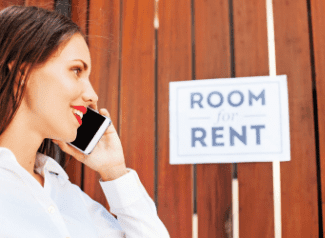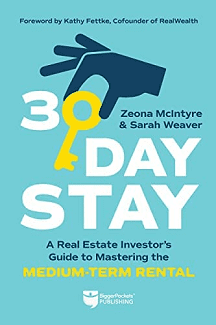Four Strategies to Help Your Cashflow in Any Market
By Zeona McIntyre, Author of 30-Day Stay: A Real Estate Investor’s Guide to Mastering the Medium-Term Rental
Since 2017, I’ve been hearing people comment on how difficult it is to find a deal – yet all the while, I have continued to buy properties. From 2017-2022, I have purchased a property (or more) every year, without any special tricks, right off the MLS (multiple listing service, or the main property database). The difference between me and the other investors is that I look at properties creatively and nine times out of ten, I can find a way to make the numbers of the deal work.
Today, I want to go over four strategies to help you spot or create deals out of seemingly average properties.
HouseHacking

Shortly after this term was born, it hit the internet by storm and a book called, “The HouseHacking Strategy” by Craig Curelop followed. These days, Craig and I record a weekly podcast show called “Invest2FI” where we teach our listeners how to achieve financial independence or “FI” by investing in Real Estate. Most of our episodes mention some form of househacking because we are such big believers in it. We see it as the most advantageous way to get started in Real Estate Investing, especially for those starting young.
The main reason we love this strategy is because it requires the least amount of cash to get started. Most people believe purchasing a home requires 20% down and that is simply not true. For an owner-occupied loan (a property that the owner plans to move into within 60 days of closing, and intends to live in for the remaining 10 months after that) one can put down as little as 3% down in some instances.
3% is often for a first-time homebuyer product, but not always. There are many different loan options, limited only by the offerings from your mortgage broker or banker, so it is worth getting some recommendations and see what a few companies have to offer. Another popular option is a 3.5% FHA (Federal Housing Administration) loan, which has a few more hoops to jump through during the appraisal process; and there are 5% and 10% down options as well. Just make sure that you are setting aside an additional 2-3% for closing costs as well.
Not only does putting little down allow one to get into a deal sooner, but it also improves your cash-on-cash return, which is a common measurement for the real estate investor.
#1 Rent-by-the-Room Strategy
In “The HouseHacking Strategy,” Craig teaches readers how to maximize the rent-by-the-room strategy, which is essentially, the age-old plan of living with roommates – but supercharged. Even though he was operating out of the expensive market of Denver, Colorado, he found that if one purchases a home meeting the following criteria, that person can achieve financial independence in five years or less – if they are willing to repeat the formula for five years.
The difference with the concept of roommates is that most people only tolerate roommates while they are a renter themselves. Once they buy, they often upgrade their lifestyle to absorb the full cost of the mortgage on their own. Beware of lifestyle creep! We believe that if you start young or with a clear goal in mind, you can delay that upgrade for a few years and in the process set yourself up for life!
Here’s the recipe:
- Find a home with 4+ bedrooms (five or more is ideal)
- The basic formula is that the rent from three of the bedrooms pays the mortgage, one room is the for the owner to live in, and the fifth room+ is cash flow.
- 2,000 sq ft.+
- An ideal layout for roommates is a home that has two living spaces. In Denver, a common layout is a main floor living room with two to three bedrooms on the floor, and a basement with an additional living space and two or more bedrooms.
- Two or more full bathrooms
- Ideally, no more than two people share a full bathroom and there is one on each floor.
- Furnish the common areas: living room, kitchen, dining, outdoor space, so that you have an attractive space that is cohesive and easy to market when looking for a new tenant.
Cons to this strategy:
Many people can weather this strategy through their 20s or early 30s, but once a long-term partner or children come into the picture, it becomes more difficult.
How to overcome this?
Start early! Even if this is not ideal for you, now that you know about it, buy the book for your younger sibling, nephew or cousin who still has time to get started.
#2 Airbnb Roommate Strategy
I was turned on to this strategy in my mid-20s and fell in love with it for a few reasons:
- The guest or tenant pays 50%-100% more than a long-term roommate.
- They are there for a short stay. Once the roommate is starting to get on your nerves with their particular quirks or habits, they leave.
- Even if you are renting the room(s) our full-time, you naturally have some gaps in the calendar and a break from roommates.
- You can live vicariously through the guests travel adventures and make connections with new friends from around the world.
- This strategy works similarly to the one above but can work with less bedrooms (allowing the investor to start with a cheaper property): two or more, since the tenants pay more.
Cons to this strategy
- In this strategy you must also furnish the bedroom spaces so the upfront investment can be slightly more.
- Beware: short-term rentals or Airbnb is restricted in some complexes.
How to overcome this?
Read through the Homeowners Association (HOA) rules and bylaws before purchasing any property.
#3 Unofficial Duplex
Say you are feeling a bit too old or past the stage in your life where you are willing to live with roommates? Fear not! There are still options for you. Here are two ways to do this model:
- The most common that we see in Colorado is the separate entrance or walkout basement. If you purchase a home with a separate entrance basement, you can finish the basement or add a kitchen (or even just a kitchenette) and rent that area as a second unit. This can be done with a long term, annual tenant or with a short-term tenant who covers most of your mortgage from shorter stays booked through a website like Airbnb.
- The second way that I have seen people creatively create a second unit in their homes, especially when they are not in an area where basements are common, is by making the primary bedroom and bathroom its own unit.
If you have a main floor primary suite, it is often accompanied by a separate entrance, usually to the backyard. This can become a separate entrance. This strategy works best for short stay tenants from a few days to month-to-month. You can turn the primary closet into a kitchenette area, and simply lock off the door that would connect the room to the rest of the house. Simple!
Cons to this strategy
Often these rooms are close to the rest of the home so privacy can be an issue.
How to overcome this?
Hang soundproofing material behind the door, either on your side of the home or both, and put carpets in the primary room to absorb sound.
#4 Multi-unit Medium-term Rentals (or mid-term, MTR) Strategy
If you are blessed to live in an area with many small multi-unit properties (2-4 unit buildings) this can be an incredible way to live officially separated from your tenants. This can work with as little as two units (or a main house with an ADU) and yet four units often gives the most amount of cash flow. I recommend up to four-unit buildings because they can still qualify for the low down payment, owner occupied loans I mentioned above.
The way to maximize this strategy is to advertise to medium-term or month-to-month tenants. While this can be done through websites like Airbnb, I recommend utilizing a site called: Furnished Finder. This website has been popularized by the traveling medical professional industry yet in recent years has expanded to a larger tenant pool. These tenants will pay 1.5-2x market rate rent, allowing you to cash flow even with today’s high purchase prices and interest rates.
Cons to this strategy
Some people feel overwhelmed by the idea of having multiple units of tenants staying an average of three months.
How to overcome this?
If you have a few rental units, like in a 4-unit building, you can keep some units as long-term rentals to have steady dependable income, while you begin to master the MTR guest rhythm.
If you are intrigued and want to learn more about this tenant pool or the Medium-term rental strategy, I just released a book through BiggerPockets called, 30 Day Stay: The Real Estate Investor’s Guide to Mastering The Medium-term Rental Strategy. To purchase the book at a discount: use code “Zeona” for 10% off.
About the Author

















 Accessibility
Accessibility